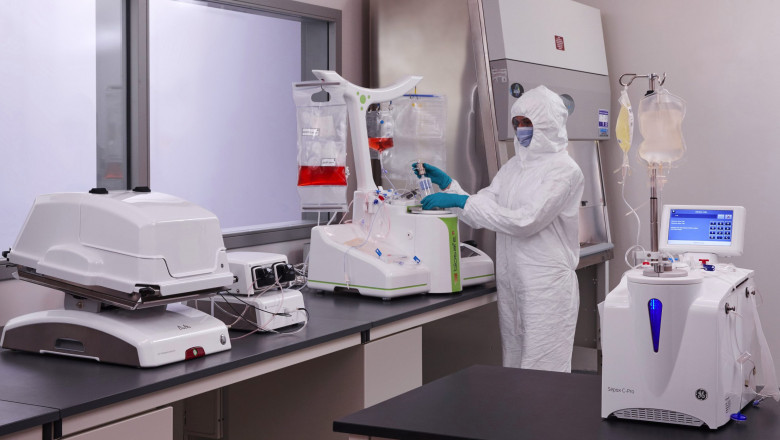views
Cell therapy involves manufacturing living human cells that can be safely administered to patients to replace or repair damaged cells, tissues, and organs. These therapies involve introducing healthy cells into the body to treat a variety of degenerative or damaged tissues and organs. Cells used for therapy can either be adult stem cells harvested from the patient or other donors or stem cells created through therapeutic cloning or reprogramming of adult somatic cells. Regardless of the source, cells must go through rigorous manufacturing processes to ensure adequate quantities, viability, and safety before being administered to patients.
Cell Source and Harvest
The first step in Cell Therapy Manufacturing involves obtaining the appropriate cell source material. Adult stem cells are often obtained from readily available sources like bone marrow, adipose tissue, or cord blood. These cells can either be obtained directly from the patient or from a donor matching the patient’s tissue type. When stem cells are needed for regenerative capabilities beyond these adult sources, alternative methods like therapeutic cloning or induced pluripotent stem cells provide additional cell sources. For cell cloning, donor egg cells have their nuclei removed and replaced with the nuclei of somatic cells from the patient. The eggs are then stimulated to divide and develop into early stem cells. Induced pluripotent stem cells are created by inserting genes that reprogram adult cells back to an embryonic-like stem cell state. Regardless of the source, cells must then be harvested using aseptic techniques to minimize contamination and maximize viability for further processing steps.
Cell Processing and Manufacturing
The second major step involves processing the harvested cells. This includes expanding cell populations through multiple passages in cell culture to obtain sufficient cell numbers required for therapies. Cells are cultured using bioreactor systems in careful environmental and nutrient conditions that maintain stemness and viability while avoiding overgrowth or cellular stress. As cells multiply, tests are regularly performed to evaluate parameters like purity, viability, identity and potency. During expansion, cells may also undergo genetic modification to introduce genes encoding proteins that enhance the therapeutic benefits once administered to patients. Quality assurance testing at each step ensures only high quality and safe cells are produced. Additional formulation and encapsulation steps may be needed to prepare cells for specific administration routes before they are ready to be released for patient treatment.
Quality Control and Standardization
Rigorous quality control and standardization are hallmarks of good manufacturing practices in cell therapy production. Testing occurs at each step to verify cell identity, purity from contamination, viability through the manufacturing process and maintenance of proper potency and phenotype. Process characterization and validation ensure consistent, reproducible methods. Environmental and personnel monitoring safeguards sterile facilities. Documentation and record keeping enable full traceability. Submission of characterization data to regulatory agencies helps set uniform release criteria. Banking of critical cell banks provides backup cell sources and enables replicability. Technology platforms and standardized protocols aid multi-site production of cellular medicines. Continual assessment and improvement of manufacturing helps translate cell therapies from bench to bedside.
Cell Therapy Administration and Delivery
Depending on the disease or condition, cells may be administered via different routes. For instances like bone marrow transplants, concentrated, infused cells are often administered intravenously. Cartilage or bone defects may employ direct injection or scaffold-based delivery of chondrocytes or mesenchymal stem cells into lesions. For neurodegenerative diseases, fetal neuronal cells may be administered stereotactically into specific brain regions. Implantable devices could one day provide encapsulated islet cells as a treatment for diabetes. Regardless of administration method, important considerations include concentrated cell dose levels, maintaining viability through delivery, limiting host immune responses, and ensuring proper localization and engraftment at target sites. Considerable research continues towards developing refined delivery strategies that promote optimal therapeutic outcomes.
Advent of Automation and Personalization
Advancing cell manufacturing technologies aim to streamline production, improve efficiencies, and enhance quality. Automation through modular closed systems incorporates process analytical tools for in-line monitoring and control. This facilitates real-time release and enables scalability from clinical to commercial levels. Integrated closed bioreactors with perfusion technology maintain optimized conditions at large volumes for commercial-scale production. Advances in process analytics allow deeper characterization of cell states and activities. Single-use assemblies avoid cross-contamination risks between runs. Artificial intelligence and machine learning open new possibilities for predictive modeling, optimization, and personalization of therapies based on patient-specific parameters. Emerging technologies are driving the transition of cell therapy manufacturing toward personalized, on-demand production of consistent cellular medicines.
Applications and Future of Cell Therapy Manufacturing
With continued progress, cell therapies offer immense potential to treat a variety of diseases. Promising applications in clinical trials involve treatments for cancers, heart disease, diabetes, neurological disorders, and more. Commercial approval of several CAR-T cell therapies highlighted the viability of this field. Areas poised for growth include regenerative medicine using mesenchymal stem cells or tissue-specific progenitors for musculoskeletal repair, wound healing, skin grafts, and reconstructive surgeries. As process technologies and analytics advance to deliver reproducible, scalable manufacturing, cell therapies move closer to widespread availability as curative and life-saving options. With further research and development, new therapeutic applications are likely for a broad range of medical conditions. With continued innovation, cell therapy manufacturing represents a rapidly growing area that could transform 21st century medicine.
Get this Report in Japanese Language: 細胞治療製造
Get this Report in Korean Language: 세포치료제 제조
About Author:
Vaagisha brings over three years of expertise as a content editor in the market research domain. Originally a creative writer, she discovered her passion for editing, combining her flair for writing with a meticulous eye for detail. Her ability to craft and refine compelling content makes her an invaluable asset in delivering polished and engaging write-ups.
(LinkedIn: https://www.linkedin.com/in/vaagisha-singh-8080b91)






















Comments
0 comment